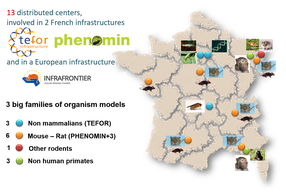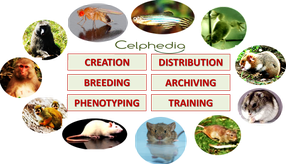 CELPHEDIA is a Research Infrastructure (RI) including thirteen centers spread throughout the French territory to be closer to the users. This distributed operational RI gathers a remarkable palette of expertise, skills and knowledge unique in Europe, in the domains of creation, functional exploration, archiving and distribution of organisms, used as models for fundamental research and preclinical approaches: rodents with the mouse as a leader, non-human primates and non mammalians including aquatic vertebrates. The goal is to enable the centers to coordinate their scientific activities and to pool all or part of their means. The geographical breakdown of the centers in France and the spread of big families of organism models, provide a better support for research to address different needs, such as enhanced security and sanitary constraints, limited use of animals and improvement of animal welfare.
CELPHEDIA is a Research Infrastructure (RI) including thirteen centers spread throughout the French territory to be closer to the users. This distributed operational RI gathers a remarkable palette of expertise, skills and knowledge unique in Europe, in the domains of creation, functional exploration, archiving and distribution of organisms, used as models for fundamental research and preclinical approaches: rodents with the mouse as a leader, non-human primates and non mammalians including aquatic vertebrates. The goal is to enable the centers to coordinate their scientific activities and to pool all or part of their means. The geographical breakdown of the centers in France and the spread of big families of organism models, provide a better support for research to address different needs, such as enhanced security and sanitary constraints, limited use of animals and improvement of animal welfare.
 CELPHEDIA enables access to most major model organisms, to answer the questions of modern biology, integrative and systemic, but also the challenges of our society. This unique access is an opportunity to develop scientific and technological multi-model approaches within the steps of creation, phenotyping or archiving. The objective is to develop and to perpetuate innovative, standardized and parallel methodologies, between the concerned model organisms, to further provide them as services to the scientific community.
CELPHEDIA enables access to most major model organisms, to answer the questions of modern biology, integrative and systemic, but also the challenges of our society. This unique access is an opportunity to develop scientific and technological multi-model approaches within the steps of creation, phenotyping or archiving. The objective is to develop and to perpetuate innovative, standardized and parallel methodologies, between the concerned model organisms, to further provide them as services to the scientific community.
The main goal of these technologies is to accelerate the comprehension of our genome and of human diseases, and to promote therapeutic innovation through the validation of molecular targets and their effects in reference model organisms. Moreover, they will enable users to conduct integrated comparative functional analyzes and to ensure better cross-functionality of the results from a model organism to another.
Furthermore, beyond the specific services provided by the centers, their federation within CELPHEDIA enables a privileged support to users, either novice or expert in the study of model organisms, thanks to a varied panel of trainings, workshops and symposiums, focused on the use of these models. This support is a key component of the missions supplied by CELPHEDIA.
Due to the capacities of the 13 partner centers, CELPHEDIA covers 3 big families of animal models: non mammalians, rodents and non-human primates.
In the last decades, the mouse has emerged as the most widely used experimental model in biomedical research (since 1970, 12 Nobel Prize winners in medicine have worked on mouse models).
The first objective of CELPHEDIA is to join the worldwide effort in decoding the functional genome, especially the mouse genome. The importance of the genetic data, the complete sequence of its genome and the phylogenetic closeness between humans and mice, made the mouse become a model of choice for all genetic and functional approaches.
Currently, non-human primates are only used in scientific experiments when there are no suitable alternative methods or species. They are mainly used in preclinical tests, but also in basic biological research, as well as in behavior and cognition programs.
More recently, the aquatic animal models (zebra-fish, xenopus) acquired a big importance as physiopathological models. Due to their short time of generation, their relative ease of breeding, the accessibility to eggs and their phylogenetic position, aquatic animal models are developed for high-throughput genetic analyses as a comparative model to mammals.
Partner centers of CELPHEDIA infrastructure interact closely with local academic structures, as well as regional private companies, around common topics. The centers are incorporated in local competitiveness clusters (ex : Alsace Biovalley, Biogenouest, LyonPôle, Cancéropôle, Eurobiomed, …). Some centers are involved in regional projects funded through Equipex (PhenoCan, PhenoMIX, ANINFIMIP, etc…).
The implication of all CELPHEDIA members in several French, European or international programs, around mutagenesis, phenotyping, archiving or distribution approaches, proves the dynamism of that network. Therefore, CELPHEDIA is guaranteed to be always at the forefront of the technological and conceptual developments in the respective fields of expertise.
CELPHEDIA participates to 7 European projects : CanPathPro - EarlyCause - EJP RD-MECPer-3D - EOSC-life - EUPRIM-Net II - INFRAFRONTIER 2020 - PathBio. CELPHEDIA was previously involved in the following projects: AgedBrainSYSBIO - EMTRAIN - EUCOMMTools - GENCODYS - InfraCoMP - INFRAFRONTIER I3 - InterReg - IPAD-MD (InfraFrontier) - MUGEN - SYBILLA
CELPHEDIA with the partners of PHENOMIN (ICS, TAAM, CIPHE), the National Infrastructure for Mouse Phenogenomics, is committed in international consortia, such as IMPC «International Mouse Phenotyping Consortium» whose goal is to create the functional encyclopedia of the mouse genome by achieving inactivation mutants of every mouse gene and by performing their exhaustive phenotyping for all major physiological functions. This consortium might lead to a functional encyclopedia of mammalian genomes being of great interest for basic, biomedical and pharmaceutical research.
This commitment will address the needs of the French community by access to new mouse models and continue by a cooperation agreement with FIMRe «Federation of International Mouse Ressource» for the preservation and the distribution of mouse models.
The centers focusing of the non-human primate model (MPRC, SdP, SILABE) have integrated EUPRIM-Net II consortium gathering nine European primatology centers. The goal is to share and to integrate their work and their knowledge in primatology, their expertise in primates breeding.